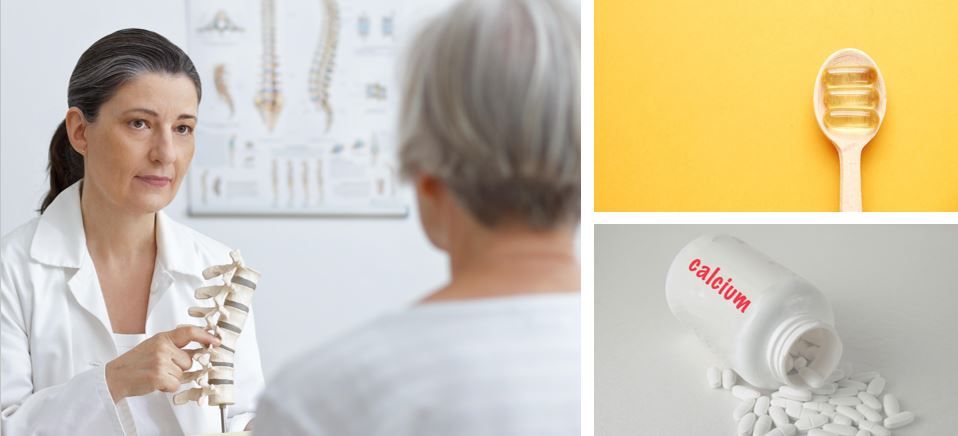Calcium and Vitamin D First to Reduce Fracture Risk?
Drug therapy appears to be the first-line option for reducing fracture risk in osteoporosis, but it is not always feasible, and increasing calcium, vitamin D and protein intake may be a more practical option.
(©Agenturfotografin,AdobeStock_299579923)

Drug therapy appears to be the first-line option for reducing fracture risk in osteoporosis, but it is not always feasible, and increasing calcium, vitamin D and protein intake may be a more practical option.
Alongside regular physical activity, a balanced nutrient intake is essential for the reduction of osteoporosis risk.
In this review published in Nutrients, Dr. Araceli Munoz-Garach, of Virgen de las Nieves Hospital in Granada, Spain, and colleagues, discuss the association of bone health with nutrition.
Calcium and vitamin D, which form part of the bone mineral matrix as calcium phosphate, are required for bone strength. The most important sources of calcium in the diet are dairy products, fish, pulses, nuts and seeds. Pharmacological calcium supplementation could be useful when dietary sources are poorly tolerated or insufficient. A majority of vitamin D is obtained from cutaneous synthesis after sunlight exposure, with a minimal amount obtained via foods, such as oily fish, mushrooms and some fortified dairy products, but no foods can provide enough vitamin D to meet requirements.
“In elderly or postmenopausal women, vitamin D deficiency may aggravate osteoporosis,” the authors wrote. “Additionally, adequate concentrations of 25-hydroxyvitamin D (25(OH)D) are necessary for maximizing the efficacy of anti-osteoporotic drugs.”
For dairy products, the beneficial role in bone health has been established in Chinese and Caucasian girls and women, but these study results have not been replicated in other populations. Moreover, no large randomized clinical trials evaluating dairy intake over long periods of time have been undertaken.
Other minerals that have an important role in bone health include potassium, which may reduce the acid load and, thus, calcium depletion from bones, and or magnesium, which is also necessary for calcium metabolism. In a nationwide Korean study, the highest intake of potassium was associated with greater lumbar, total hip, and femur neck bone mineral density in men older than 50 years and postmenopausal women. While no randomized trials evaluating the effect of magnesium on bone disease are available, small-size studies have associated low serum magnesium levels with osteoporosis.
Protein intake is also essential for bone health. Adequate protein intake is essential for bone matrix formation and maintenance, and it has been shown that there is no adverse effect of higher protein intake on bone. The European Society for Clinical and Economic Aspects of Osteoporosis and Osteoarthritis (ESCEO) recommends a daily dietary protein intake of 1.0–1.2 g/kg body weight, with at least 20–25 g of high-quality protein at each main meal.
While vitamin K is involved in bone matrix formation during mineralization, few trials exist and a clinically meaningful effect of vitamin K on bone mineral density has not been shown. Vitamin C can improve bone health due to its antioxidant properties. A recent meta-analysis supported previous findings that increasing dietary vitamin C intake could decrease the risk of hip fractures, but there is little information in clinical practice guidelines in terms of vitamin C intake. Fruit and vegetables are rich potassium and magnesium, and in vitamin C, vitamin K, folate and carotenoids.
Folate and vitamin B-12 might also influence bone by reducing homocysteine concentrations, which is linked to lower bone mineral density and a higher risk of fracture. Meanwhile, lower serum and bone zinc concentrations have been described in patients with osteoporosis. The evidence regarding the effects of omega-3 polyunsaturated fatty acids on bone metabolism is conflicting, and, as with all nutrients, further study is needed.
Dietary pattern studies are more useful than single-nutrient and food studies for revealing the effects of different nutrients alone on bone health. However, the majority of studies assessing the association between bone mineral status or fracture risk and dietary patterns had a cross-sectional design, which have influenced their results and further conclusions.
“In general, a dietary pattern with a high intake of fruit, vegetables, low-fat dairy products, whole grains, poultry, fish, nuts and legumes has been demonstrated to have a positive effect on bone health and directly associated with a better bone mineral density and lower risk of fracture,” the authors wrote. “An adequate calcium intake seems to be recommendable for bone health, regardless of dietary preferences.”
________________
REFERENCE
Marina Morato-Martínez, Bricia López-Plaza, Manuel Muñoz-Torres. “Nutrients and Dietary Patterns Related to Osteoporosis.” Nutrients. July 4, 2020. https://doi.org/10.3390/nu12071986